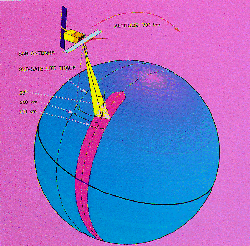Climate and Computer Modelling
The temperature patterns of our global oceans and the seas around Australia influence changes in rainfall and the evolution of our climate, which are important issues for our environment and several primary industries.

Changes in the ocean also affect our maritime industries such as oil and gas production.
Understanding and predicting these changes requires detail knowledge of the ocean and of the links between marine systems and climate.
Computer-based ocean models are now able to accurately simulate and, in some cases, predict the temperature, and salinity, sea level and currents of the Indian, Pacific and Southern Oceans. These oceans most directly impact the Australian climate and its environment.
Through work with the Bureau of Meteorology Research Centre, and the assistance of Land and Water Australia's Climate Variability in Agriculture Program, scientists at CSIRO Marine and Atmospheric Research are using advance computer facilities to develop and improve ocean models for a large variety of environmental and climate applications. Key facilities are the High Performance Computing and Communication Centre (HPCCC) in Melbourne, and the Tasmanian Partnership for Advanced Computing in Hobart and lead by the University of Tasmania.
These ocean models are able to capture those processes such as upper ocean heat storage, that are believed to be important influences on Australian climate. Coupled with the Bureau's atmospheric model, they provide an ability to predict droughts and floods. (In its seasonal outlooks, the Bureau's National Climate Centre refers to the state of tropical Pacific and Indian Ocean ocean conditions as key influences).
The results from these coupled models give primary producers and resource managers a better basis for long-term planning and decision-making. The coupled models are being incorporated into the operational systems of the Bureau and will provide regular forecasts for seasonal climate variations with lead-times in excess of six months.

Two global ocean models are being run on the HPCCC SX-5 machines; one with coarse resolution suited to climate studies, the other having a finer resolution for regional research. Both models are based on the Modular Ocean Model code developed by the Geophysical Fluid Dynamics Laboratory (Princeton, USA).
The finer resolution model is able to simulate details of the Leeuwin Current and the East Australian Currents, as well as the Indonesian throughflow, all of which are important influences on Australia.
The Blue Ocean Forecasting Australia project being developed by the Bureau of Meteorology Research Centre, CSIRO and the Royal Australian Navy centres on ocean prediction-analysis and forecasting of day-to-day variations in ocean currents and temperature.
The project will enable resolution and simulation of fine-scale features such as eddies associated with topography and coastal currents, aspects that are very important for a number of applications, including defence.
These models also have other applications and users - local fishing communities, primary producers and agricultural marketing authorities, government agencies responsible for ecosystem management, shipping and transport and risk management in industries such as oil and gas production.
 Deep Sea Crabs
Deep Sea Crabs